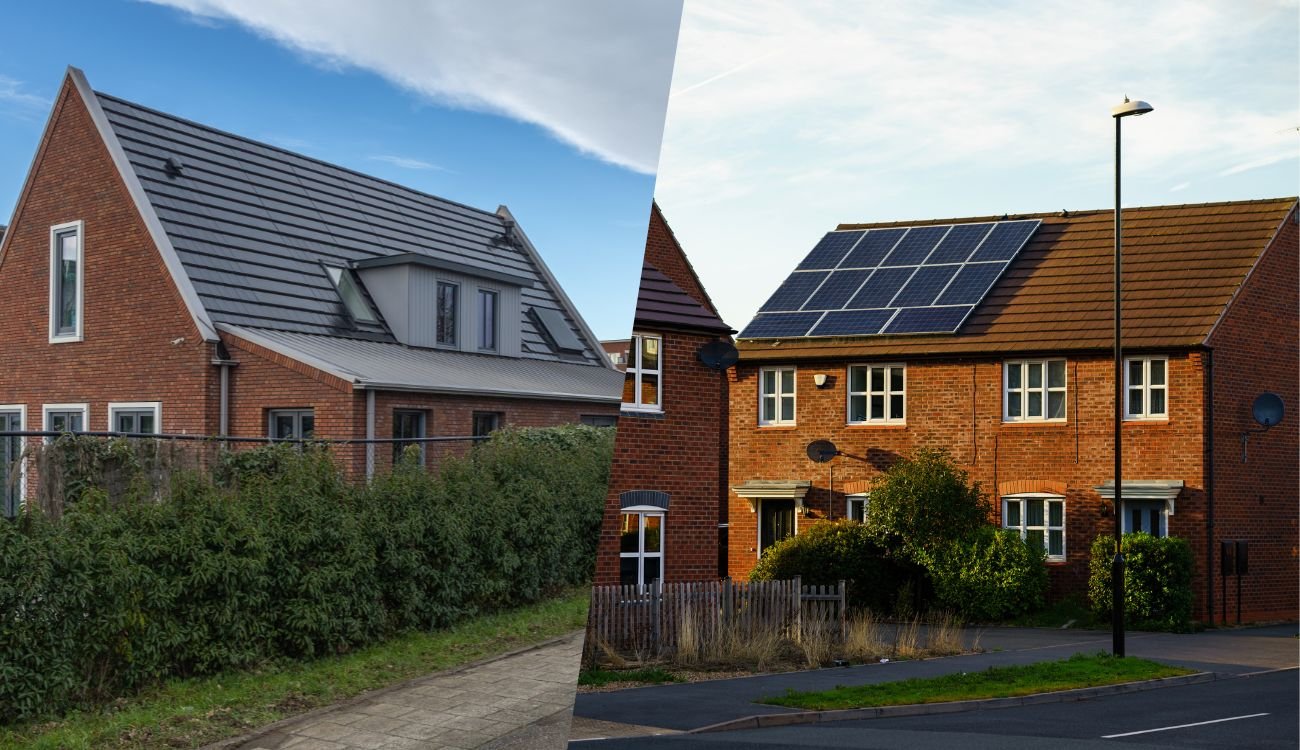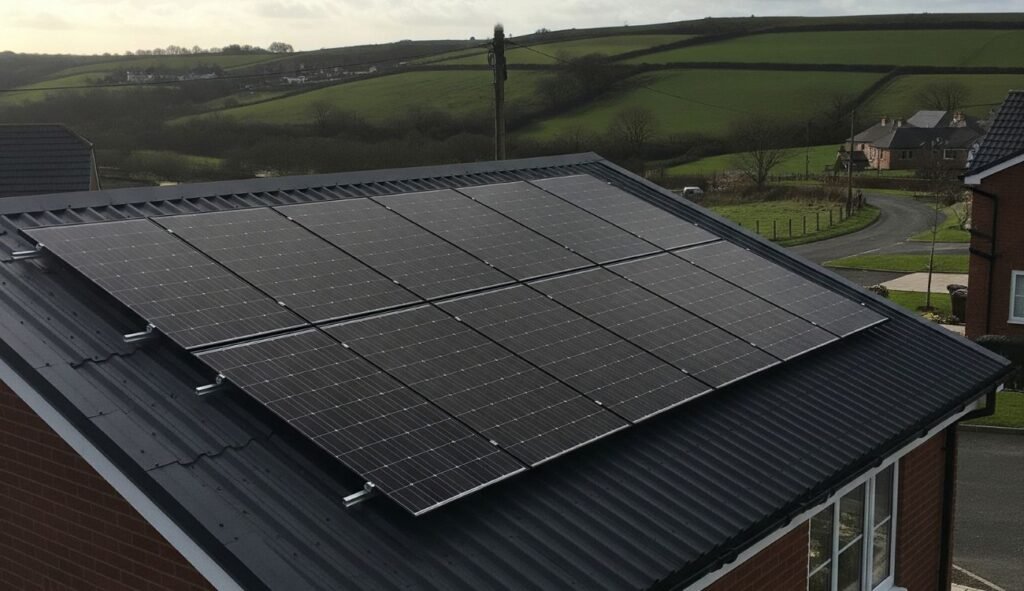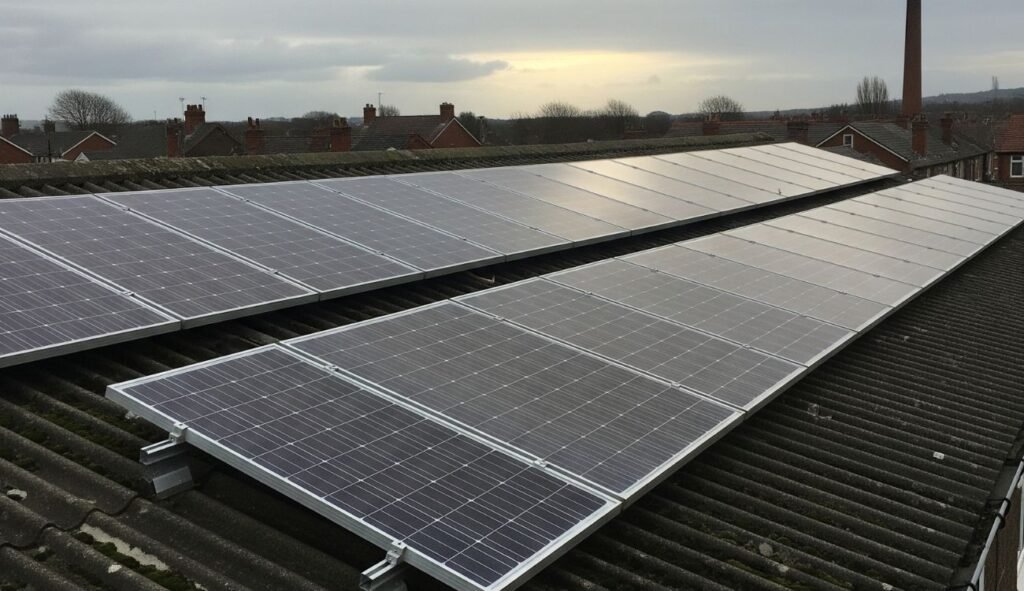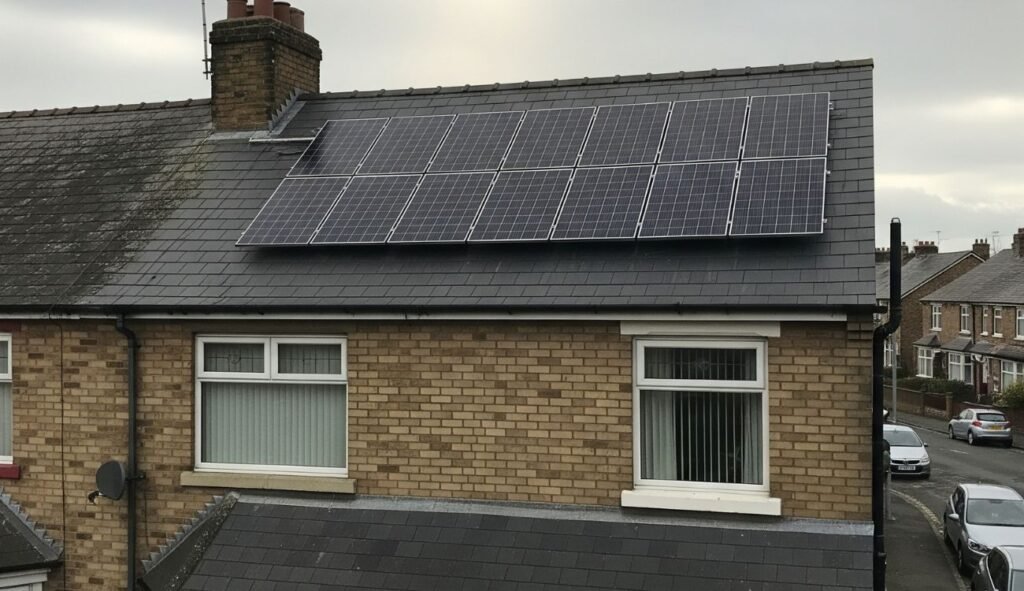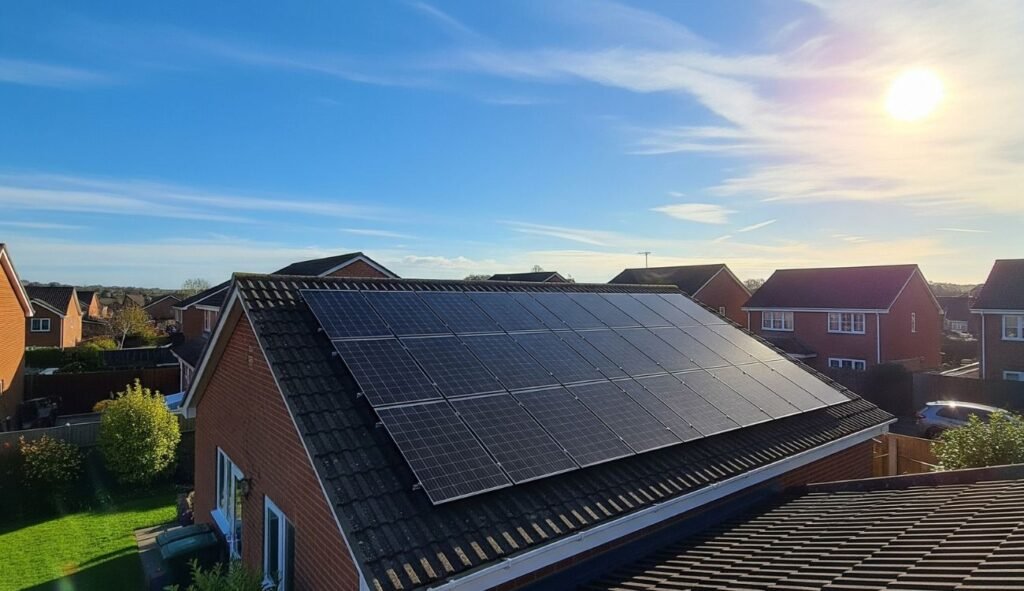Solar energy adoption in the UK is on the rise, with over 1.5 million homes now equipped with solar panels.
This surge is driven by increasing energy costs, environmental concerns, and government initiatives aiming to triple solar capacity by 2030.
For homeowners, landlords, and commercial property owners, understanding the differences between solar tiles and traditional solar panels is vital to making an informed investment.
Solar Tiles vs Solar Panels: A Quick Comparison
| Feature | Solar Panels | Solar Tiles |
|---|---|---|
| Visibility | High | Low (blends into roof) |
| Aesthetics | Bulkier look | Sleek, integrated design |
| Efficiency | Higher (15–22%) | Slightly lower (10–17%) |
| Cost | Lower upfront (£5,000–£9,000) | Higher upfront (£11,000–£24,000+) |
| Installation Time | Faster | Longer (more complex) |
| Roof Compatibility | Retrofit-friendly | Often requires full roof replacement |
| Ideal For | Budget-conscious, existing roofs | New builds, listed buildings, premium homes |
What Is the Difference Between Solar Tiles and Solar Panels?
Solar Tiles
Solar tiles, or solar roof tiles, are photovoltaic cells designed to mimic traditional roofing materials. They integrate seamlessly into the roof, offering a discreet alternative to conventional panels.
Pros
- Aesthetically pleasing; blends with roof design.
- Ideal for listed buildings and conservation areas.
- Durable and weather-resistant.
- Can increase property value.
Cons
- Higher installation costs.
- Lower efficiency compared to panels.
- Longer installation time.
- Requires full roof replacement in most cases.
Solar Panels
Traditional solar panels are mounted on top of existing roofs and are the most common solar energy systems in the UK.
Pros
- Higher efficiency rates.
- Lower upfront costs.
- Easier to install and maintain.
- Suitable for most roof types.
Cons
- Visibly prominent; may not suit all aesthetics.
- May require planning permission in conservation areas.
- Adds weight to the existing roof structure.
Not sure whether solar tiles or traditional panels are right for your home? Future Heat is MCS certified and proudly serves Tyne and Wear, Newcastle, and the North East, offering expert guidance to help you choose the most efficient and cost-effective solar solution.
Request your free solar panel quote today and start your journey to clean energy.
Solar Tiles vs Solar Panel Costs
| Property Type | Estimated Energy Needs (kWh/year) | Recommended System Size (kW) | No. of Solar Panels Needed | No. of Solar Tiles Needed (approx.) | Cost for Panels (Installed) | Cost for Tiles (Installed) |
|---|---|---|---|---|---|---|
| 1-bedroom flat | ~2,000 | 2 | 5–6 | ~10–12 tiles | £4,000–£5,000 | £10,000–£12,000 |
| 2-bedroom terraced house | ~3,000 | 3 | 8–9 | ~16–18 tiles | £5,000–£6,500 | £13,000–£16,000 |
| 3-bedroom semi-detached | ~4,500 | 4 | 10–12 | ~20–24 tiles | £6,000–£7,500 | £15,000–£20,000 |
| 4-bedroom detached | ~5,500 | 5 | 12–14 | ~25–28 tiles | £7,000–£9,000 | £18,000–£24,000 |
| Small commercial building | ~8,000–10,000 | 8–10 | 20–24 | ~40–50 tiles | £12,000–£15,000 | £30,000+ |
Installation Requirements
Solar panels can be retrofitted onto most existing roofs with minimal alterations. Installation is relatively quick, often completed within a few days.
Solar tiles, however, typically require a full roof replacement, making them more suitable for new builds or major renovations. Installation is more complex and time-consuming.
Planning permission is generally not required for solar panels, except in conservation areas or listed buildings. Solar tiles are often preferred in these areas due to their discreet appearance.
What Type of Property Is Best Suited for Solar Tiles or Solar Panels?
Solar Tiles:
- New builds.
- Heritage or listed buildings.
- High-end homes where aesthetics are a priority.
Solar Panels:
- Most domestic homes and flats.
- Retrofits on existing roofs.
- Commercial buildings with large roof spaces.
Roof Compatibility
Solar Panels:
- Can be mounted on most UK roof types (tile, slate, flat roofs with angled mounts).
- Require minimal roof alteration.
- Suitable for older properties.
Solar Tiles:
- Usually installed during roof replacement or new builds.
- Not suitable for all roof pitches or structural layouts.
- It may not be viable for fragile or irregular roofs.
Other compatibility factors:
- Roof orientation and angle affect both options.
- Structural integrity needs assessment, especially for tile systems.
Solar Tiles vs Solar Panels: Compatibility with Other Home Systems
Both solar tiles and panels can be integrated with:
- Solar batteries for energy storage.
- Grid-tied systems to sell excess energy.
- Combi boilers, though additional equipment may be needed.
Which Is More Efficient: Solar Tiles or Solar Panels?
Solar panels typically have efficiency rates between 15% and 22%, while solar tiles range from 10% to 17%. Panels benefit from better airflow and can be angled optimally, enhancing performance.
Tiles, being flush with the roof, may have reduced airflow and are limited to the roof’s pitch, potentially decreasing efficiency.
In the UK’s less sunny climate, maximising efficiency is key, especially during colder months, as solar panels do work during winter, but may not be as effective.
Homes with limited roof space may find that higher-efficiency panels offer better value per square metre.
Which Lasts Longer: Solar Tiles or Solar Panels?
Both solar panels and tiles have lifespans of around 25 to 30 years. Panels are more exposed but are designed to withstand UK weather conditions.
Tiles, integrated into the roof, offer better protection against wind damage.
Maintenance for panels is generally easier, as individual units can be replaced. Tiles may require more work to service or replace faulty sections.
Warranty terms vary; panels often have separate product and performance warranties, while tile warranties may be tied to the roof installation.
Solar Tiles vs Solar Panels: Aesthetics
When it comes to how your solar setup looks, aesthetics can be a major deciding factor, especially for homeowners aiming to preserve their property’s kerb appeal.
Both solar panels and solar tiles offer clean energy, but they do so with very different visual impacts.
Solar tiles
Solar roof tiles are designed to blend in with traditional roofing materials.
Whether you’re building a new home or re-roofing an older property, solar tiles provide a sleek, modern, and low-profile appearance.
From street level, it’s often difficult to tell the difference between solar tiles and conventional slate or tile roofing.
For properties in conservation areas or with strict planning restrictions, solar tiles in the UK are becoming increasingly popular as they offer a way to install solar technology without compromising heritage aesthetics.
Solar Panels
Traditional solar panels, while efficient and cost-effective, are bulkier and typically mounted on top of your existing roof.
This raised and noticeable design can contrast sharply with older or character homes, which is why some homeowners feel they detract from the property’s appearance.
That said, modern options like all-black monocrystalline panels have significantly improved in design.
These panels offer a more uniform, minimalist finish compared to the older blue-and-silver polycrystalline styles.
While not invisible, today’s solar panels are a step forward in balancing performance with appearance.
If you’re concerned about how panels will look on your roof, it’s also worth considering the layout and orientation. A well-planned installation can enhance symmetry and curb appeal.
Read our guide on horizontal vs vertical solar panel installation to understand the aesthetic differences.
If you’d rather avoid roof-mounted panels altogether, ground-mounted solar systems can be a great alternative, especially if you have available garden space.
These setups remove any visual impact on your roof and allow for optimised positioning to maximise sunlight exposure.
Solar Tiles vs Solar Panels: Energy Generation
Under typical UK conditions:
- Solar Panels: Standard panels produce between 350 and 450W each.
- Solar Tiles: Generally have lower output per m², requiring more tiles to generate the same energy as panels.
For example, a 4 kW panel system may need approximately 10–12 panels, while a tile system would require a larger roof area and more tiles to achieve the same output.
Which Is Better for Your Home or Business in the UK: Solar Tiles or Solar Panels?
Choose Solar Panels if:
- You’re budget-conscious
- You have an existing roof suitable for retrofitting
- You prioritise efficiency over aesthetics
Choose Solar Tiles if:
- You’re undertaking a new build or major renovation
- Your property is listed or in a conservation area
- Aesthetics are a top priority
Frequently Asked Questions (FAQs)
Yes, solar tiles can be advantageous for homes with intricate roof layouts. Their smaller size and modular design allow them to fit into various configurations, accommodating roofs with multiple angles, dormers, or obstructions.
This flexibility enables higher energy offsets in challenging roof scenarios compared to standard solar panels.
Solar tiles are generally lighter than traditional solar panels. This reduced weight can be beneficial for roofs that might not support the additional load of panel systems without reinforcement.
However, it’s essential to have a structural assessment to ensure roof compatibility before installation.
Absolutely. Solar tiles are designed to blend seamlessly with traditional roofing materials, making them ideal for neighbourhoods with strict aesthetic guidelines or homeowners associations (HOAs).
Their discreet appearance often complies with regulations that might prohibit conventional solar panels.
Yes, the adoption of solar tiles is still emerging, and as a result, there are fewer installers specialising in this technology compared to traditional solar panels.This limited availability can affect installation timelines and service options in certain regions.
Solar tiles often come with warranties comparable to those of solar panels, typically around 25 years.
However, since solar tiles serve both as roofing material and energy generators, their warranties might encompass both aspects. It’s important to review the specific terms provided by the manufacturer and installer.
Our Verdict
Solar panels offer a cost-effective and efficient solution for most UK properties, especially existing homes and commercial buildings. Solar tiles, while more expensive, provide an aesthetically pleasing option.
Myles Robinson is a seasoned expert in the boiler and home improvement industry, with over a decade of experience. He is deeply committed to environmental sustainability, actively promoting energy-efficient heating solutions to help households reduce their carbon footprint. By combining industry expertise with a dedication to environmental responsibility, Myles continues to lead efforts in transforming home heating practices towards a more sustainable future.

